Economic and Financial Management: Impact on Business and Accounting Ratios
VerifiedAdded on 2023/01/13
|15
|3212
|64
AI Summary
This study explores the impact of economic factors on business and the importance of accounting ratios. It focuses on Sainsbury, a leading supermarket chain in the UK, and analyzes its performance over three years. The report provides insights into macro and microeconomic factors, computing ratios, and their significance in the business.
Contribute Materials
Your contribution can guide someone’s learning journey. Share your
documents today.
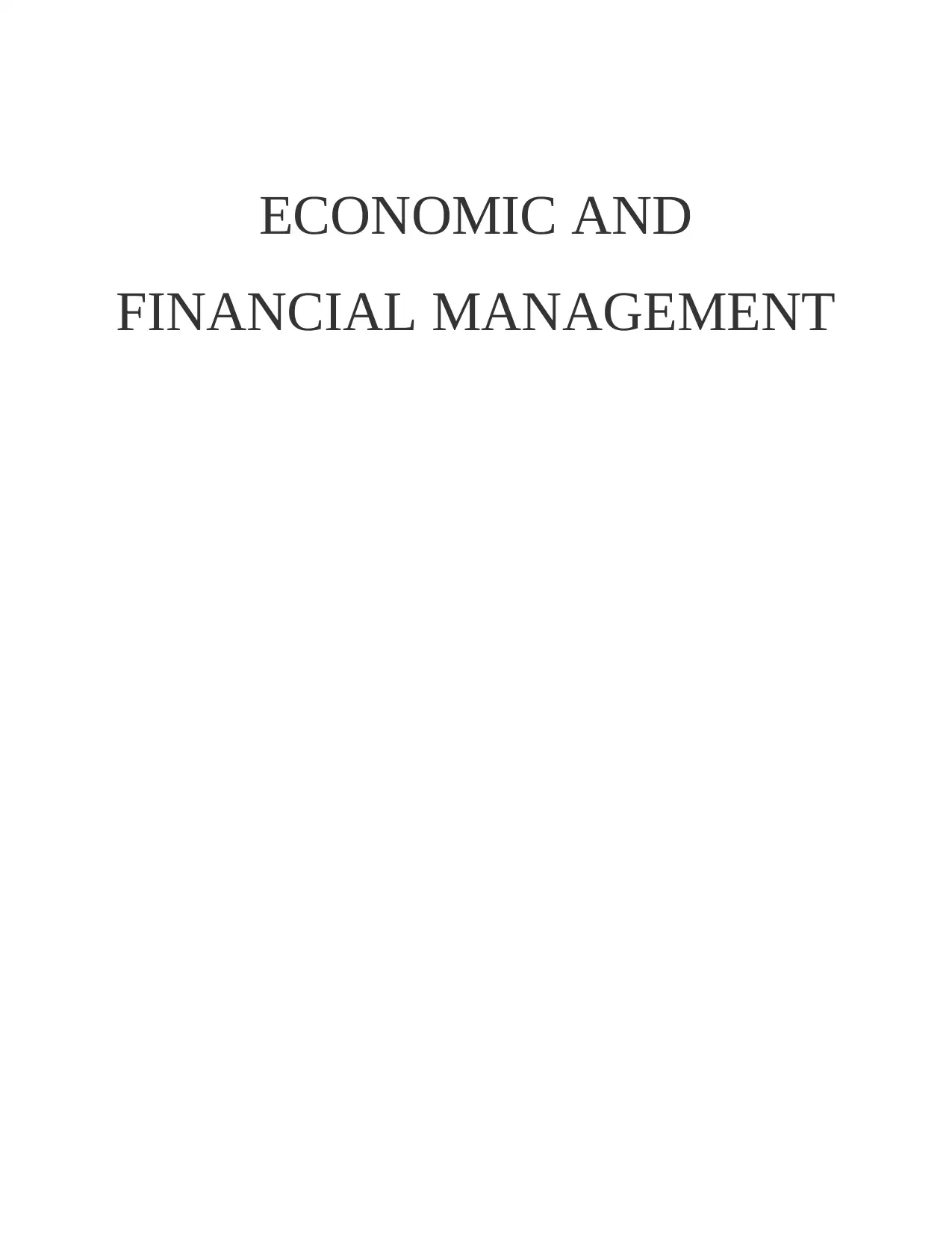
ECONOMIC AND
FINANCIAL MANAGEMENT
FINANCIAL MANAGEMENT
Secure Best Marks with AI Grader
Need help grading? Try our AI Grader for instant feedback on your assignments.
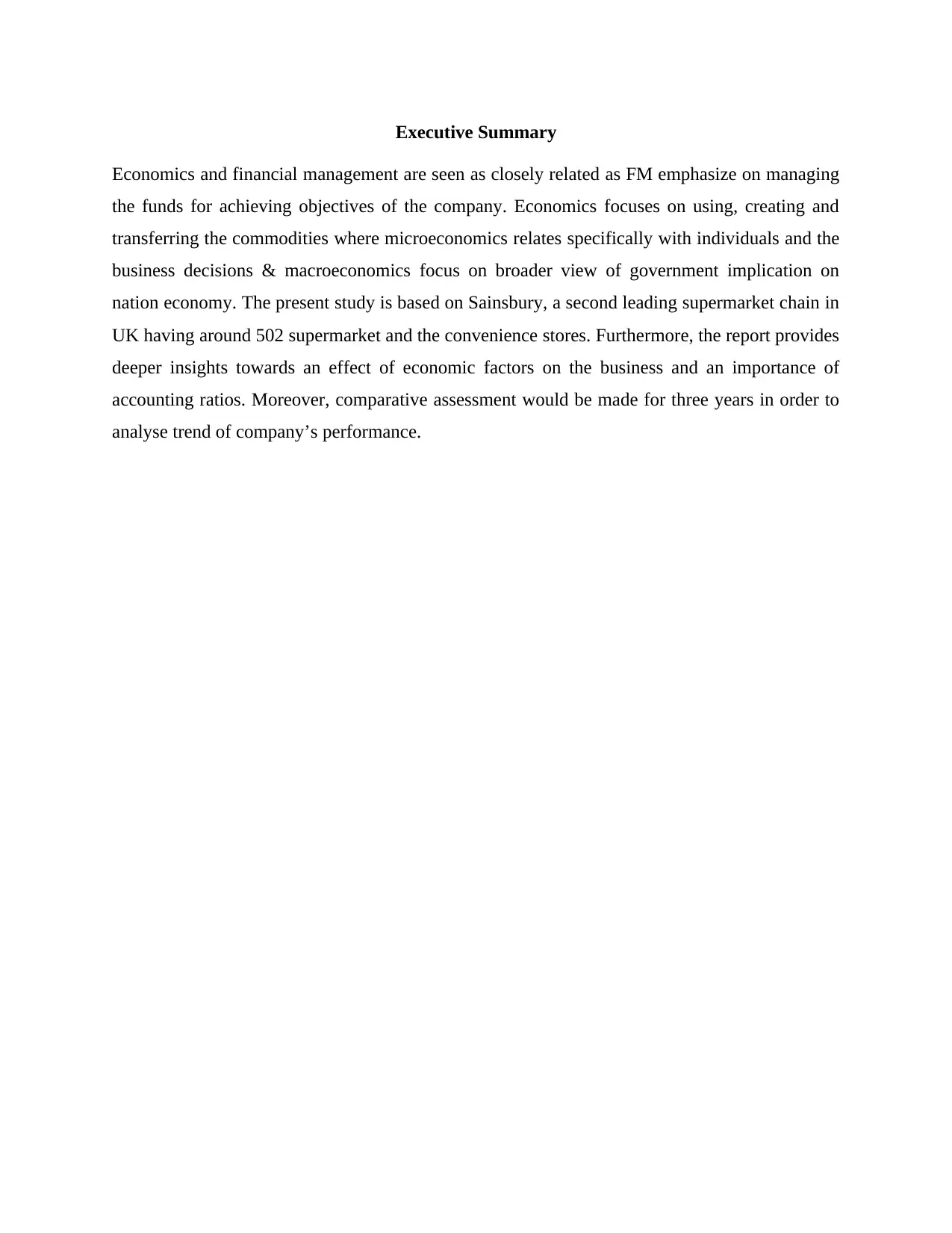
Executive Summary
Economics and financial management are seen as closely related as FM emphasize on managing
the funds for achieving objectives of the company. Economics focuses on using, creating and
transferring the commodities where microeconomics relates specifically with individuals and the
business decisions & macroeconomics focus on broader view of government implication on
nation economy. The present study is based on Sainsbury, a second leading supermarket chain in
UK having around 502 supermarket and the convenience stores. Furthermore, the report provides
deeper insights towards an effect of economic factors on the business and an importance of
accounting ratios. Moreover, comparative assessment would be made for three years in order to
analyse trend of company’s performance.
Economics and financial management are seen as closely related as FM emphasize on managing
the funds for achieving objectives of the company. Economics focuses on using, creating and
transferring the commodities where microeconomics relates specifically with individuals and the
business decisions & macroeconomics focus on broader view of government implication on
nation economy. The present study is based on Sainsbury, a second leading supermarket chain in
UK having around 502 supermarket and the convenience stores. Furthermore, the report provides
deeper insights towards an effect of economic factors on the business and an importance of
accounting ratios. Moreover, comparative assessment would be made for three years in order to
analyse trend of company’s performance.
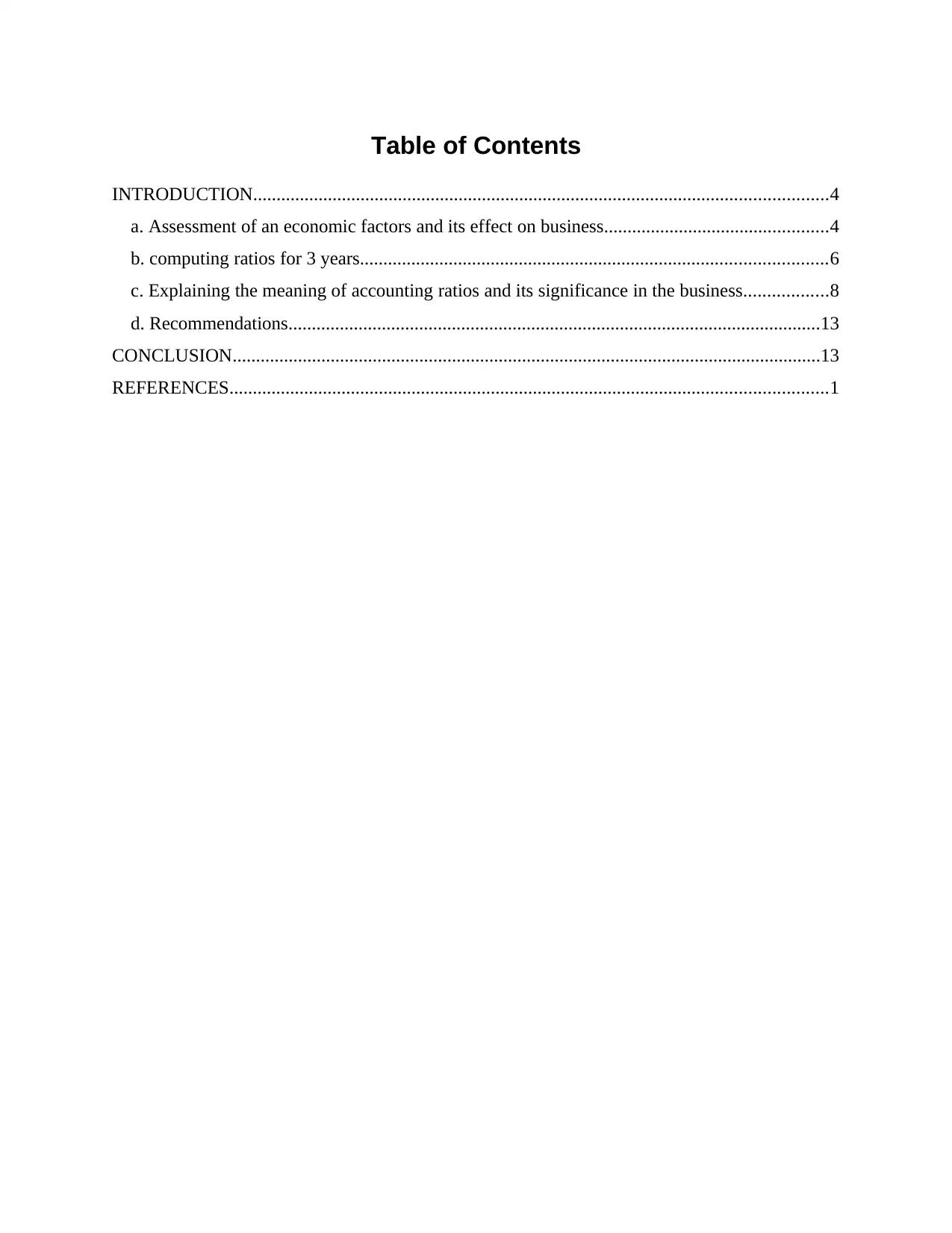
Table of Contents
INTRODUCTION...........................................................................................................................4
a. Assessment of an economic factors and its effect on business................................................4
b. computing ratios for 3 years....................................................................................................6
c. Explaining the meaning of accounting ratios and its significance in the business..................8
d. Recommendations..................................................................................................................13
CONCLUSION..............................................................................................................................13
REFERENCES................................................................................................................................1
INTRODUCTION...........................................................................................................................4
a. Assessment of an economic factors and its effect on business................................................4
b. computing ratios for 3 years....................................................................................................6
c. Explaining the meaning of accounting ratios and its significance in the business..................8
d. Recommendations..................................................................................................................13
CONCLUSION..............................................................................................................................13
REFERENCES................................................................................................................................1
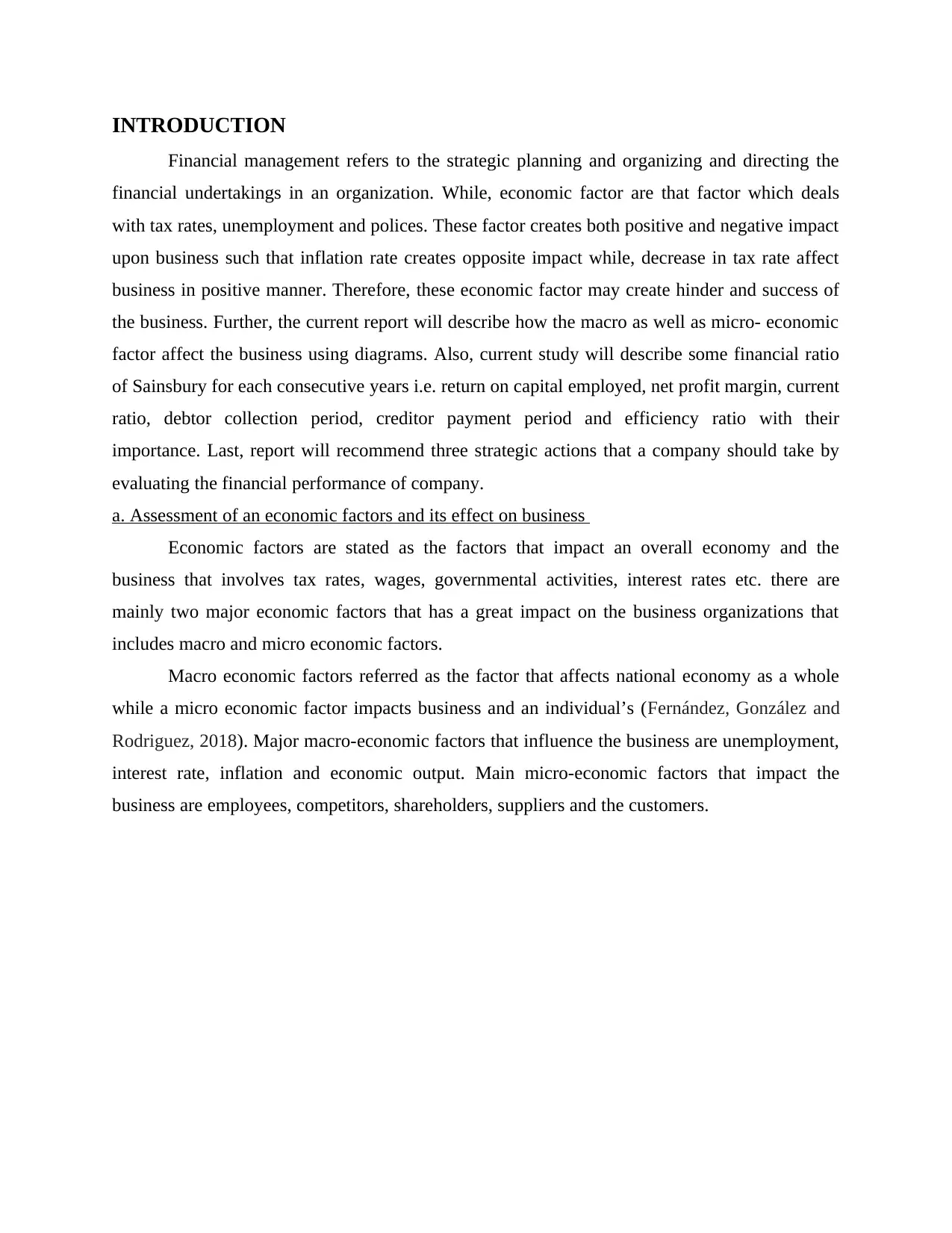
INTRODUCTION
Financial management refers to the strategic planning and organizing and directing the
financial undertakings in an organization. While, economic factor are that factor which deals
with tax rates, unemployment and polices. These factor creates both positive and negative impact
upon business such that inflation rate creates opposite impact while, decrease in tax rate affect
business in positive manner. Therefore, these economic factor may create hinder and success of
the business. Further, the current report will describe how the macro as well as micro- economic
factor affect the business using diagrams. Also, current study will describe some financial ratio
of Sainsbury for each consecutive years i.e. return on capital employed, net profit margin, current
ratio, debtor collection period, creditor payment period and efficiency ratio with their
importance. Last, report will recommend three strategic actions that a company should take by
evaluating the financial performance of company.
a. Assessment of an economic factors and its effect on business
Economic factors are stated as the factors that impact an overall economy and the
business that involves tax rates, wages, governmental activities, interest rates etc. there are
mainly two major economic factors that has a great impact on the business organizations that
includes macro and micro economic factors.
Macro economic factors referred as the factor that affects national economy as a whole
while a micro economic factor impacts business and an individual’s (Fernández, González and
Rodriguez, 2018). Major macro-economic factors that influence the business are unemployment,
interest rate, inflation and economic output. Main micro-economic factors that impact the
business are employees, competitors, shareholders, suppliers and the customers.
Financial management refers to the strategic planning and organizing and directing the
financial undertakings in an organization. While, economic factor are that factor which deals
with tax rates, unemployment and polices. These factor creates both positive and negative impact
upon business such that inflation rate creates opposite impact while, decrease in tax rate affect
business in positive manner. Therefore, these economic factor may create hinder and success of
the business. Further, the current report will describe how the macro as well as micro- economic
factor affect the business using diagrams. Also, current study will describe some financial ratio
of Sainsbury for each consecutive years i.e. return on capital employed, net profit margin, current
ratio, debtor collection period, creditor payment period and efficiency ratio with their
importance. Last, report will recommend three strategic actions that a company should take by
evaluating the financial performance of company.
a. Assessment of an economic factors and its effect on business
Economic factors are stated as the factors that impact an overall economy and the
business that involves tax rates, wages, governmental activities, interest rates etc. there are
mainly two major economic factors that has a great impact on the business organizations that
includes macro and micro economic factors.
Macro economic factors referred as the factor that affects national economy as a whole
while a micro economic factor impacts business and an individual’s (Fernández, González and
Rodriguez, 2018). Major macro-economic factors that influence the business are unemployment,
interest rate, inflation and economic output. Main micro-economic factors that impact the
business are employees, competitors, shareholders, suppliers and the customers.
Secure Best Marks with AI Grader
Need help grading? Try our AI Grader for instant feedback on your assignments.
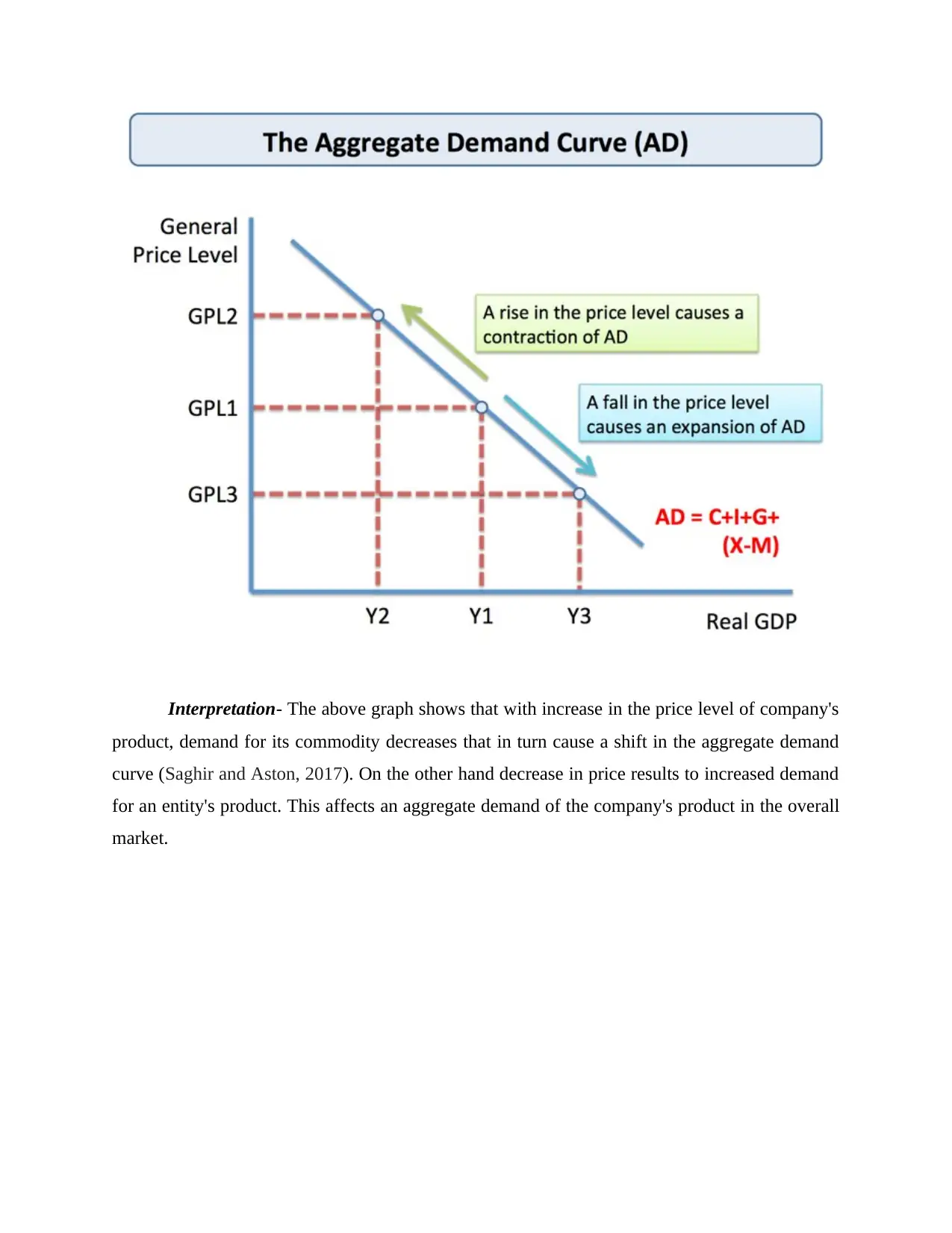
Interpretation- The above graph shows that with increase in the price level of company's
product, demand for its commodity decreases that in turn cause a shift in the aggregate demand
curve (Saghir and Aston, 2017). On the other hand decrease in price results to increased demand
for an entity's product. This affects an aggregate demand of the company's product in the overall
market.
product, demand for its commodity decreases that in turn cause a shift in the aggregate demand
curve (Saghir and Aston, 2017). On the other hand decrease in price results to increased demand
for an entity's product. This affects an aggregate demand of the company's product in the overall
market.
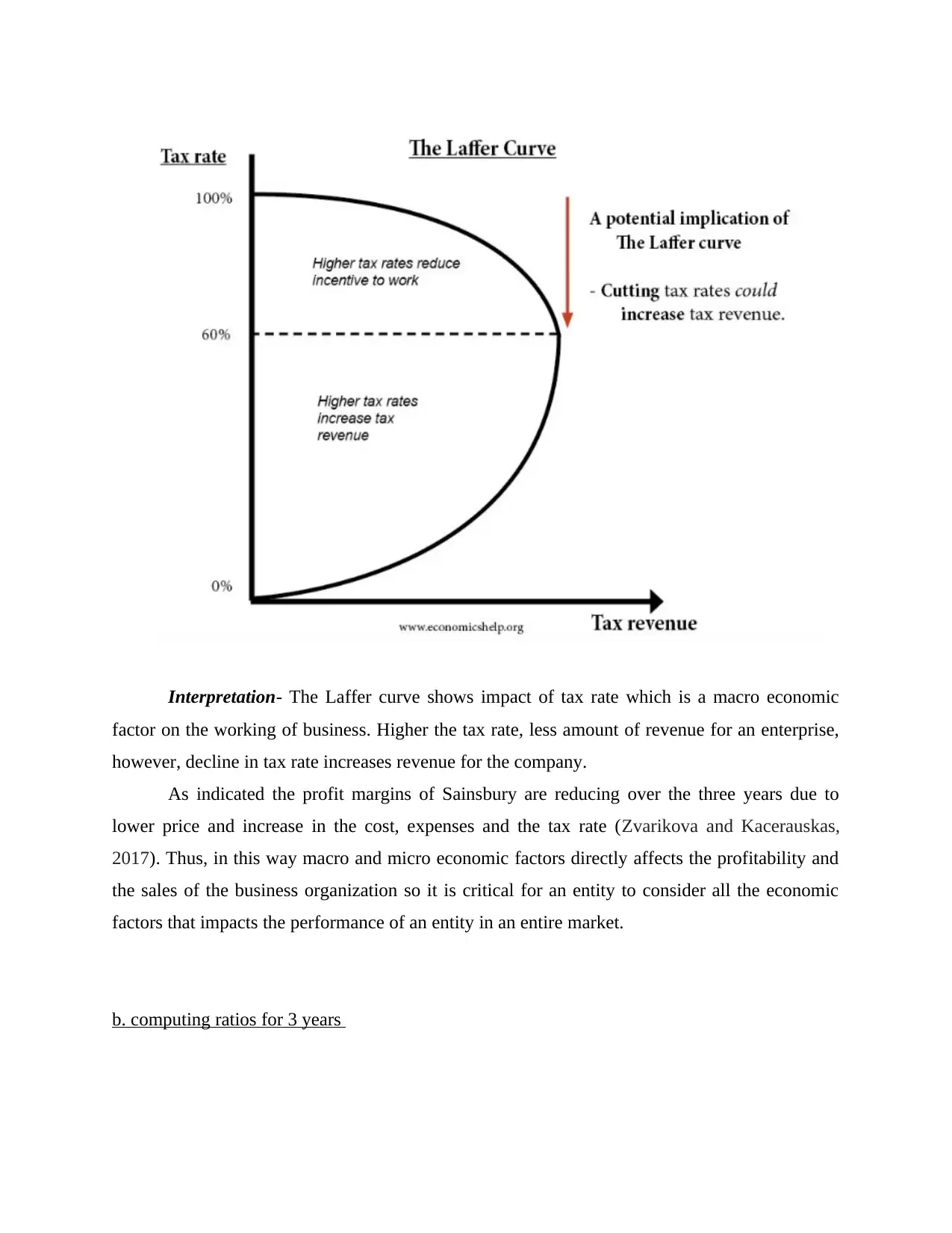
Interpretation- The Laffer curve shows impact of tax rate which is a macro economic
factor on the working of business. Higher the tax rate, less amount of revenue for an enterprise,
however, decline in tax rate increases revenue for the company.
As indicated the profit margins of Sainsbury are reducing over the three years due to
lower price and increase in the cost, expenses and the tax rate (Zvarikova and Kacerauskas,
2017). Thus, in this way macro and micro economic factors directly affects the profitability and
the sales of the business organization so it is critical for an entity to consider all the economic
factors that impacts the performance of an entity in an entire market.
b. computing ratios for 3 years
factor on the working of business. Higher the tax rate, less amount of revenue for an enterprise,
however, decline in tax rate increases revenue for the company.
As indicated the profit margins of Sainsbury are reducing over the three years due to
lower price and increase in the cost, expenses and the tax rate (Zvarikova and Kacerauskas,
2017). Thus, in this way macro and micro economic factors directly affects the profitability and
the sales of the business organization so it is critical for an entity to consider all the economic
factors that impacts the performance of an entity in an entire market.
b. computing ratios for 3 years
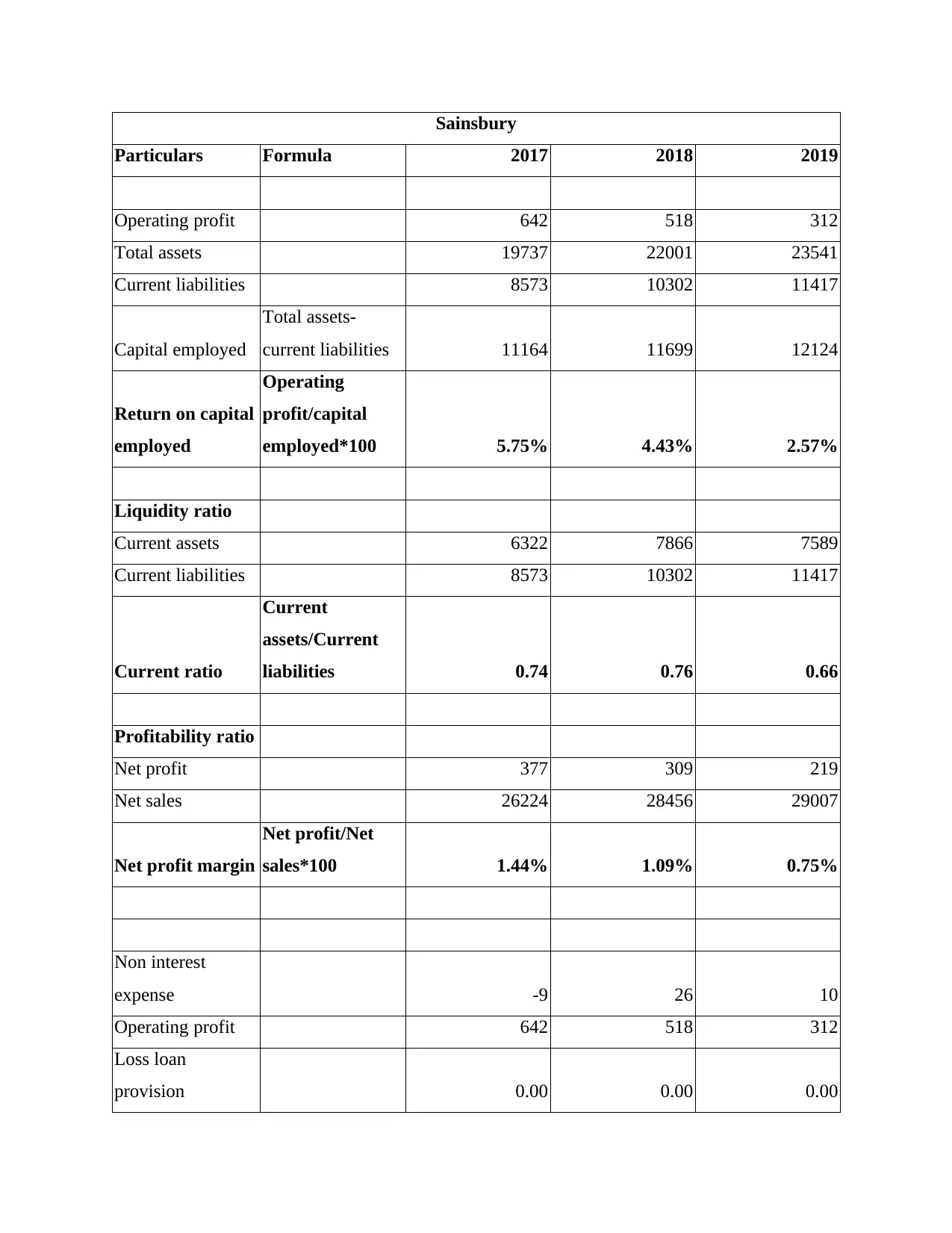
Sainsbury
Particulars Formula 2017 2018 2019
Operating profit 642 518 312
Total assets 19737 22001 23541
Current liabilities 8573 10302 11417
Capital employed
Total assets-
current liabilities 11164 11699 12124
Return on capital
employed
Operating
profit/capital
employed*100 5.75% 4.43% 2.57%
Liquidity ratio
Current assets 6322 7866 7589
Current liabilities 8573 10302 11417
Current ratio
Current
assets/Current
liabilities 0.74 0.76 0.66
Profitability ratio
Net profit 377 309 219
Net sales 26224 28456 29007
Net profit margin
Net profit/Net
sales*100 1.44% 1.09% 0.75%
Non interest
expense -9 26 10
Operating profit 642 518 312
Loss loan
provision 0.00 0.00 0.00
Particulars Formula 2017 2018 2019
Operating profit 642 518 312
Total assets 19737 22001 23541
Current liabilities 8573 10302 11417
Capital employed
Total assets-
current liabilities 11164 11699 12124
Return on capital
employed
Operating
profit/capital
employed*100 5.75% 4.43% 2.57%
Liquidity ratio
Current assets 6322 7866 7589
Current liabilities 8573 10302 11417
Current ratio
Current
assets/Current
liabilities 0.74 0.76 0.66
Profitability ratio
Net profit 377 309 219
Net sales 26224 28456 29007
Net profit margin
Net profit/Net
sales*100 1.44% 1.09% 0.75%
Non interest
expense -9 26 10
Operating profit 642 518 312
Loss loan
provision 0.00 0.00 0.00
Paraphrase This Document
Need a fresh take? Get an instant paraphrase of this document with our AI Paraphraser
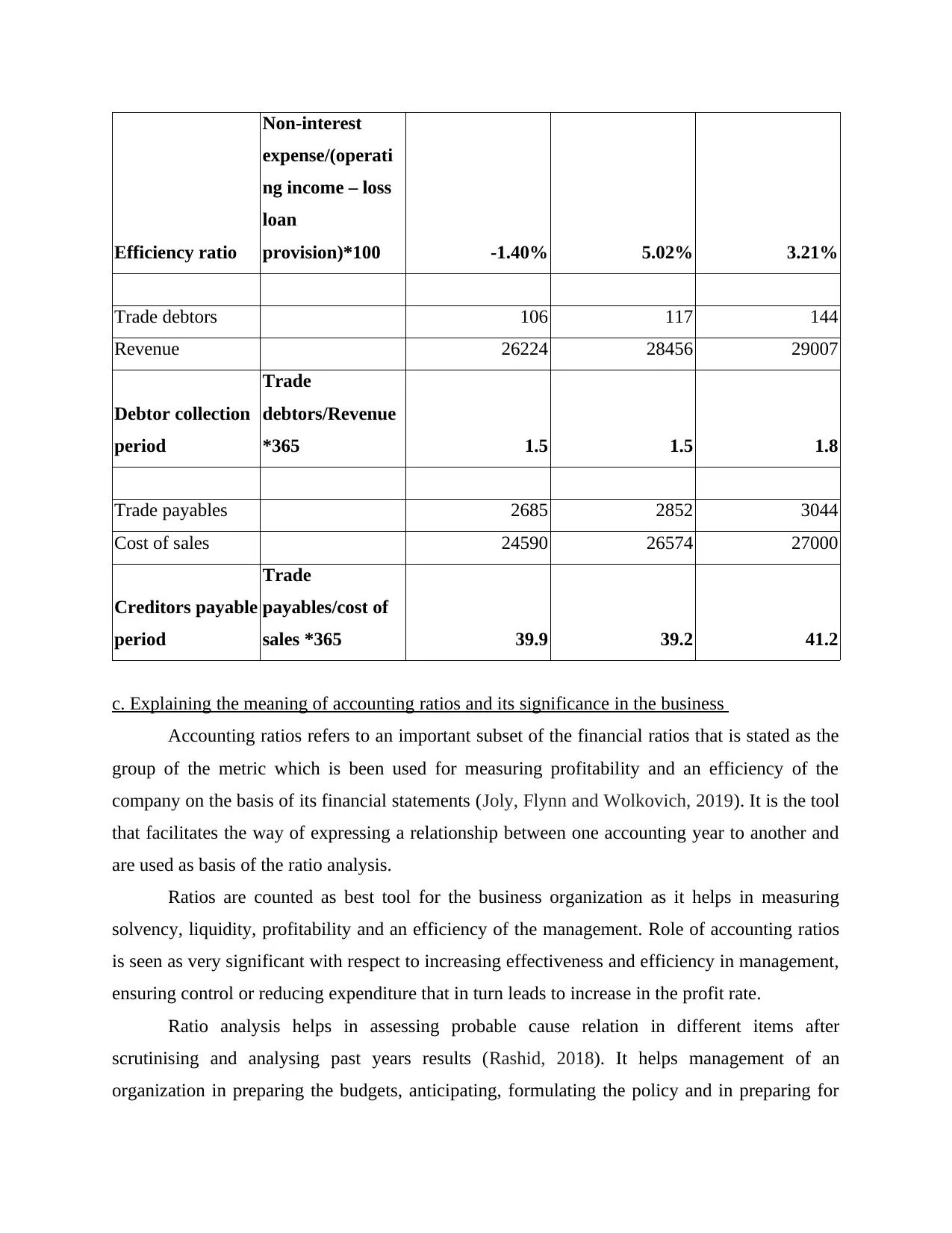
Efficiency ratio
Non-interest
expense/(operati
ng income – loss
loan
provision)*100 -1.40% 5.02% 3.21%
Trade debtors 106 117 144
Revenue 26224 28456 29007
Debtor collection
period
Trade
debtors/Revenue
*365 1.5 1.5 1.8
Trade payables 2685 2852 3044
Cost of sales 24590 26574 27000
Creditors payable
period
Trade
payables/cost of
sales *365 39.9 39.2 41.2
c. Explaining the meaning of accounting ratios and its significance in the business
Accounting ratios refers to an important subset of the financial ratios that is stated as the
group of the metric which is been used for measuring profitability and an efficiency of the
company on the basis of its financial statements (Joly, Flynn and Wolkovich, 2019). It is the tool
that facilitates the way of expressing a relationship between one accounting year to another and
are used as basis of the ratio analysis.
Ratios are counted as best tool for the business organization as it helps in measuring
solvency, liquidity, profitability and an efficiency of the management. Role of accounting ratios
is seen as very significant with respect to increasing effectiveness and efficiency in management,
ensuring control or reducing expenditure that in turn leads to increase in the profit rate.
Ratio analysis helps in assessing probable cause relation in different items after
scrutinising and analysing past years results (Rashid, 2018). It helps management of an
organization in preparing the budgets, anticipating, formulating the policy and in preparing for
Non-interest
expense/(operati
ng income – loss
loan
provision)*100 -1.40% 5.02% 3.21%
Trade debtors 106 117 144
Revenue 26224 28456 29007
Debtor collection
period
Trade
debtors/Revenue
*365 1.5 1.5 1.8
Trade payables 2685 2852 3044
Cost of sales 24590 26574 27000
Creditors payable
period
Trade
payables/cost of
sales *365 39.9 39.2 41.2
c. Explaining the meaning of accounting ratios and its significance in the business
Accounting ratios refers to an important subset of the financial ratios that is stated as the
group of the metric which is been used for measuring profitability and an efficiency of the
company on the basis of its financial statements (Joly, Flynn and Wolkovich, 2019). It is the tool
that facilitates the way of expressing a relationship between one accounting year to another and
are used as basis of the ratio analysis.
Ratios are counted as best tool for the business organization as it helps in measuring
solvency, liquidity, profitability and an efficiency of the management. Role of accounting ratios
is seen as very significant with respect to increasing effectiveness and efficiency in management,
ensuring control or reducing expenditure that in turn leads to increase in the profit rate.
Ratio analysis helps in assessing probable cause relation in different items after
scrutinising and analysing past years results (Rashid, 2018). It helps management of an
organization in preparing the budgets, anticipating, formulating the policy and in preparing for
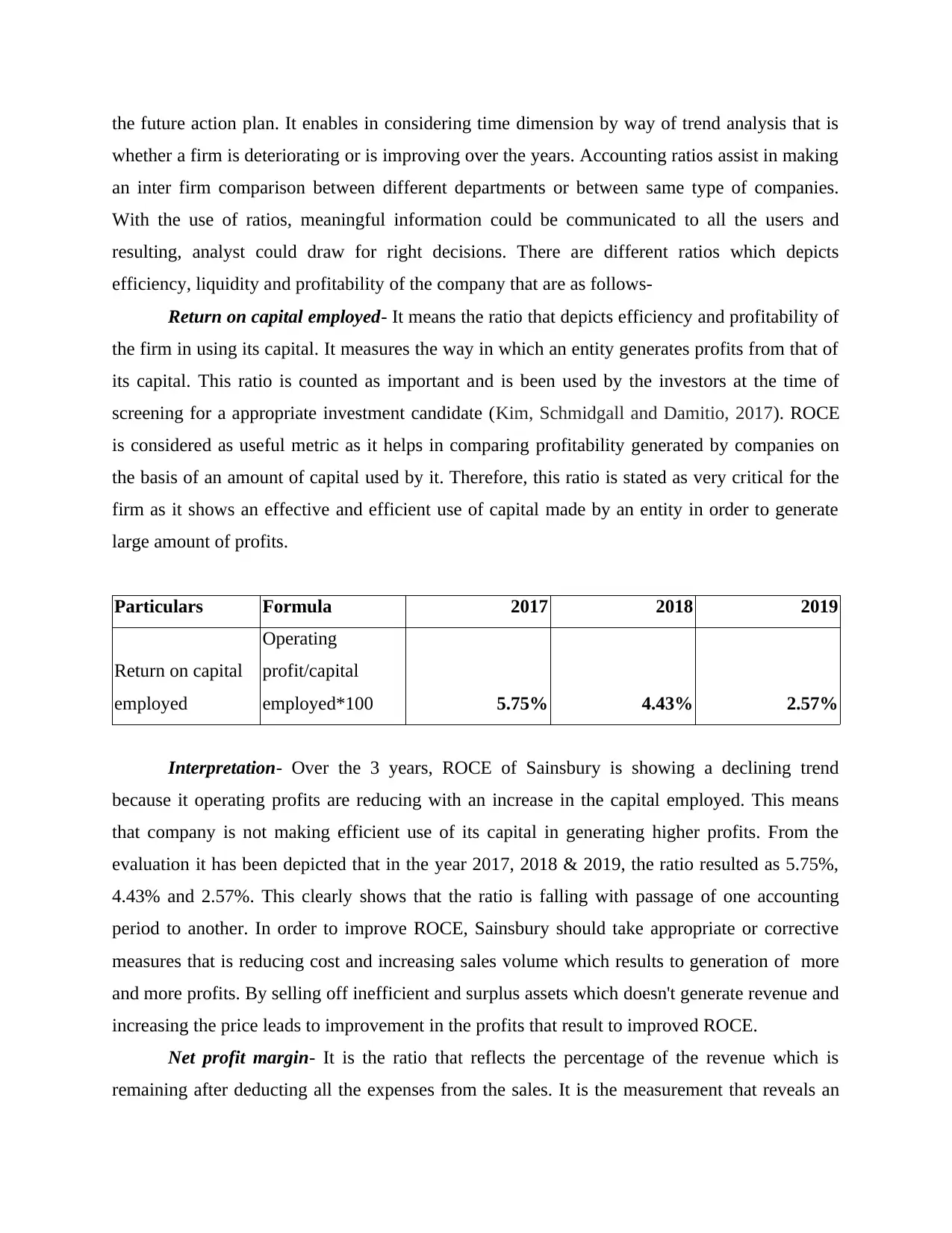
the future action plan. It enables in considering time dimension by way of trend analysis that is
whether a firm is deteriorating or is improving over the years. Accounting ratios assist in making
an inter firm comparison between different departments or between same type of companies.
With the use of ratios, meaningful information could be communicated to all the users and
resulting, analyst could draw for right decisions. There are different ratios which depicts
efficiency, liquidity and profitability of the company that are as follows-
Return on capital employed- It means the ratio that depicts efficiency and profitability of
the firm in using its capital. It measures the way in which an entity generates profits from that of
its capital. This ratio is counted as important and is been used by the investors at the time of
screening for a appropriate investment candidate (Kim, Schmidgall and Damitio, 2017). ROCE
is considered as useful metric as it helps in comparing profitability generated by companies on
the basis of an amount of capital used by it. Therefore, this ratio is stated as very critical for the
firm as it shows an effective and efficient use of capital made by an entity in order to generate
large amount of profits.
Particulars Formula 2017 2018 2019
Return on capital
employed
Operating
profit/capital
employed*100 5.75% 4.43% 2.57%
Interpretation- Over the 3 years, ROCE of Sainsbury is showing a declining trend
because it operating profits are reducing with an increase in the capital employed. This means
that company is not making efficient use of its capital in generating higher profits. From the
evaluation it has been depicted that in the year 2017, 2018 & 2019, the ratio resulted as 5.75%,
4.43% and 2.57%. This clearly shows that the ratio is falling with passage of one accounting
period to another. In order to improve ROCE, Sainsbury should take appropriate or corrective
measures that is reducing cost and increasing sales volume which results to generation of more
and more profits. By selling off inefficient and surplus assets which doesn't generate revenue and
increasing the price leads to improvement in the profits that result to improved ROCE.
Net profit margin- It is the ratio that reflects the percentage of the revenue which is
remaining after deducting all the expenses from the sales. It is the measurement that reveals an
whether a firm is deteriorating or is improving over the years. Accounting ratios assist in making
an inter firm comparison between different departments or between same type of companies.
With the use of ratios, meaningful information could be communicated to all the users and
resulting, analyst could draw for right decisions. There are different ratios which depicts
efficiency, liquidity and profitability of the company that are as follows-
Return on capital employed- It means the ratio that depicts efficiency and profitability of
the firm in using its capital. It measures the way in which an entity generates profits from that of
its capital. This ratio is counted as important and is been used by the investors at the time of
screening for a appropriate investment candidate (Kim, Schmidgall and Damitio, 2017). ROCE
is considered as useful metric as it helps in comparing profitability generated by companies on
the basis of an amount of capital used by it. Therefore, this ratio is stated as very critical for the
firm as it shows an effective and efficient use of capital made by an entity in order to generate
large amount of profits.
Particulars Formula 2017 2018 2019
Return on capital
employed
Operating
profit/capital
employed*100 5.75% 4.43% 2.57%
Interpretation- Over the 3 years, ROCE of Sainsbury is showing a declining trend
because it operating profits are reducing with an increase in the capital employed. This means
that company is not making efficient use of its capital in generating higher profits. From the
evaluation it has been depicted that in the year 2017, 2018 & 2019, the ratio resulted as 5.75%,
4.43% and 2.57%. This clearly shows that the ratio is falling with passage of one accounting
period to another. In order to improve ROCE, Sainsbury should take appropriate or corrective
measures that is reducing cost and increasing sales volume which results to generation of more
and more profits. By selling off inefficient and surplus assets which doesn't generate revenue and
increasing the price leads to improvement in the profits that result to improved ROCE.
Net profit margin- It is the ratio that reflects the percentage of the revenue which is
remaining after deducting all the expenses from the sales. It is the measurement that reveals an
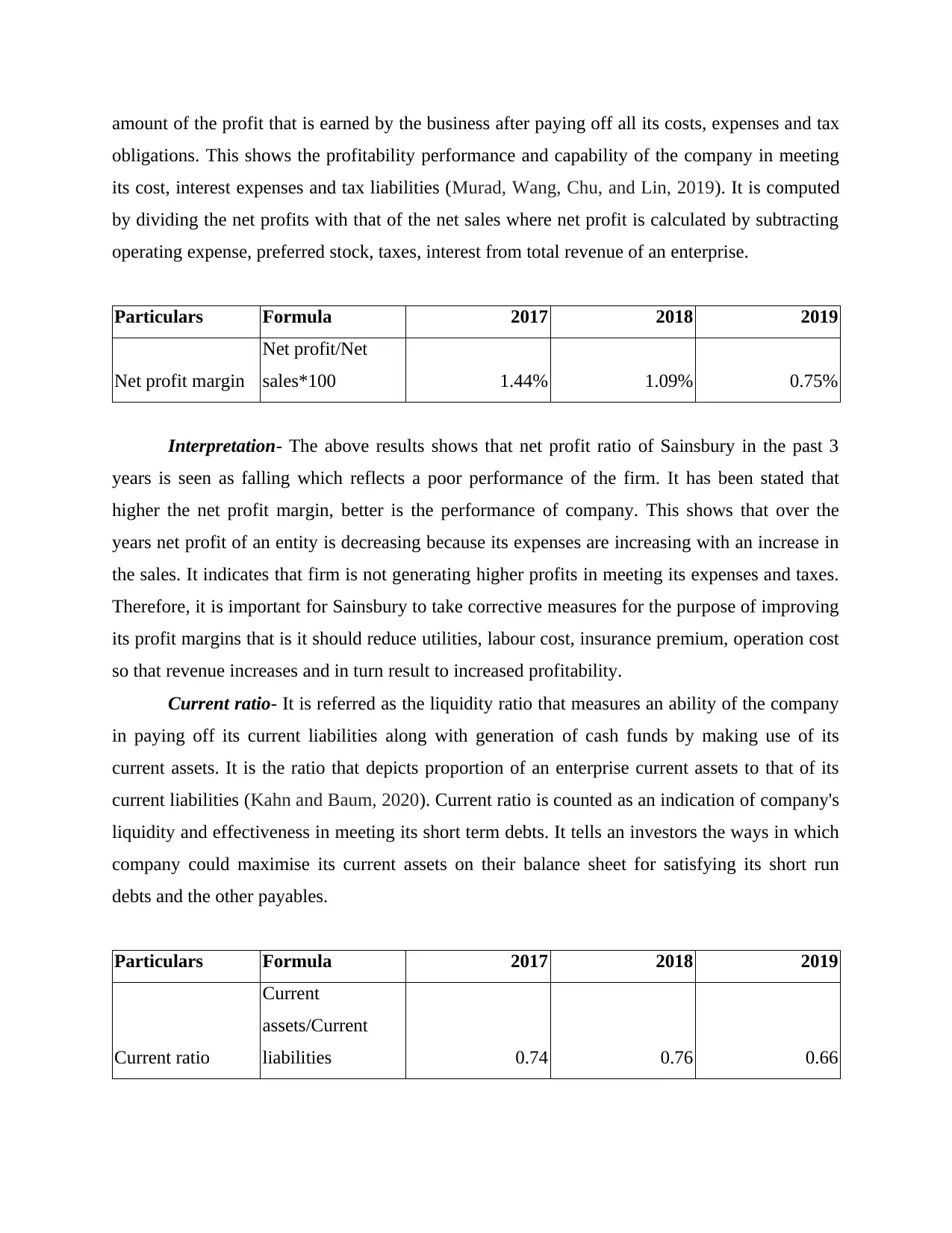
amount of the profit that is earned by the business after paying off all its costs, expenses and tax
obligations. This shows the profitability performance and capability of the company in meeting
its cost, interest expenses and tax liabilities (Murad, Wang, Chu, and Lin, 2019). It is computed
by dividing the net profits with that of the net sales where net profit is calculated by subtracting
operating expense, preferred stock, taxes, interest from total revenue of an enterprise.
Particulars Formula 2017 2018 2019
Net profit margin
Net profit/Net
sales*100 1.44% 1.09% 0.75%
Interpretation- The above results shows that net profit ratio of Sainsbury in the past 3
years is seen as falling which reflects a poor performance of the firm. It has been stated that
higher the net profit margin, better is the performance of company. This shows that over the
years net profit of an entity is decreasing because its expenses are increasing with an increase in
the sales. It indicates that firm is not generating higher profits in meeting its expenses and taxes.
Therefore, it is important for Sainsbury to take corrective measures for the purpose of improving
its profit margins that is it should reduce utilities, labour cost, insurance premium, operation cost
so that revenue increases and in turn result to increased profitability.
Current ratio- It is referred as the liquidity ratio that measures an ability of the company
in paying off its current liabilities along with generation of cash funds by making use of its
current assets. It is the ratio that depicts proportion of an enterprise current assets to that of its
current liabilities (Kahn and Baum, 2020). Current ratio is counted as an indication of company's
liquidity and effectiveness in meeting its short term debts. It tells an investors the ways in which
company could maximise its current assets on their balance sheet for satisfying its short run
debts and the other payables.
Particulars Formula 2017 2018 2019
Current ratio
Current
assets/Current
liabilities 0.74 0.76 0.66
obligations. This shows the profitability performance and capability of the company in meeting
its cost, interest expenses and tax liabilities (Murad, Wang, Chu, and Lin, 2019). It is computed
by dividing the net profits with that of the net sales where net profit is calculated by subtracting
operating expense, preferred stock, taxes, interest from total revenue of an enterprise.
Particulars Formula 2017 2018 2019
Net profit margin
Net profit/Net
sales*100 1.44% 1.09% 0.75%
Interpretation- The above results shows that net profit ratio of Sainsbury in the past 3
years is seen as falling which reflects a poor performance of the firm. It has been stated that
higher the net profit margin, better is the performance of company. This shows that over the
years net profit of an entity is decreasing because its expenses are increasing with an increase in
the sales. It indicates that firm is not generating higher profits in meeting its expenses and taxes.
Therefore, it is important for Sainsbury to take corrective measures for the purpose of improving
its profit margins that is it should reduce utilities, labour cost, insurance premium, operation cost
so that revenue increases and in turn result to increased profitability.
Current ratio- It is referred as the liquidity ratio that measures an ability of the company
in paying off its current liabilities along with generation of cash funds by making use of its
current assets. It is the ratio that depicts proportion of an enterprise current assets to that of its
current liabilities (Kahn and Baum, 2020). Current ratio is counted as an indication of company's
liquidity and effectiveness in meeting its short term debts. It tells an investors the ways in which
company could maximise its current assets on their balance sheet for satisfying its short run
debts and the other payables.
Particulars Formula 2017 2018 2019
Current ratio
Current
assets/Current
liabilities 0.74 0.76 0.66
Secure Best Marks with AI Grader
Need help grading? Try our AI Grader for instant feedback on your assignments.
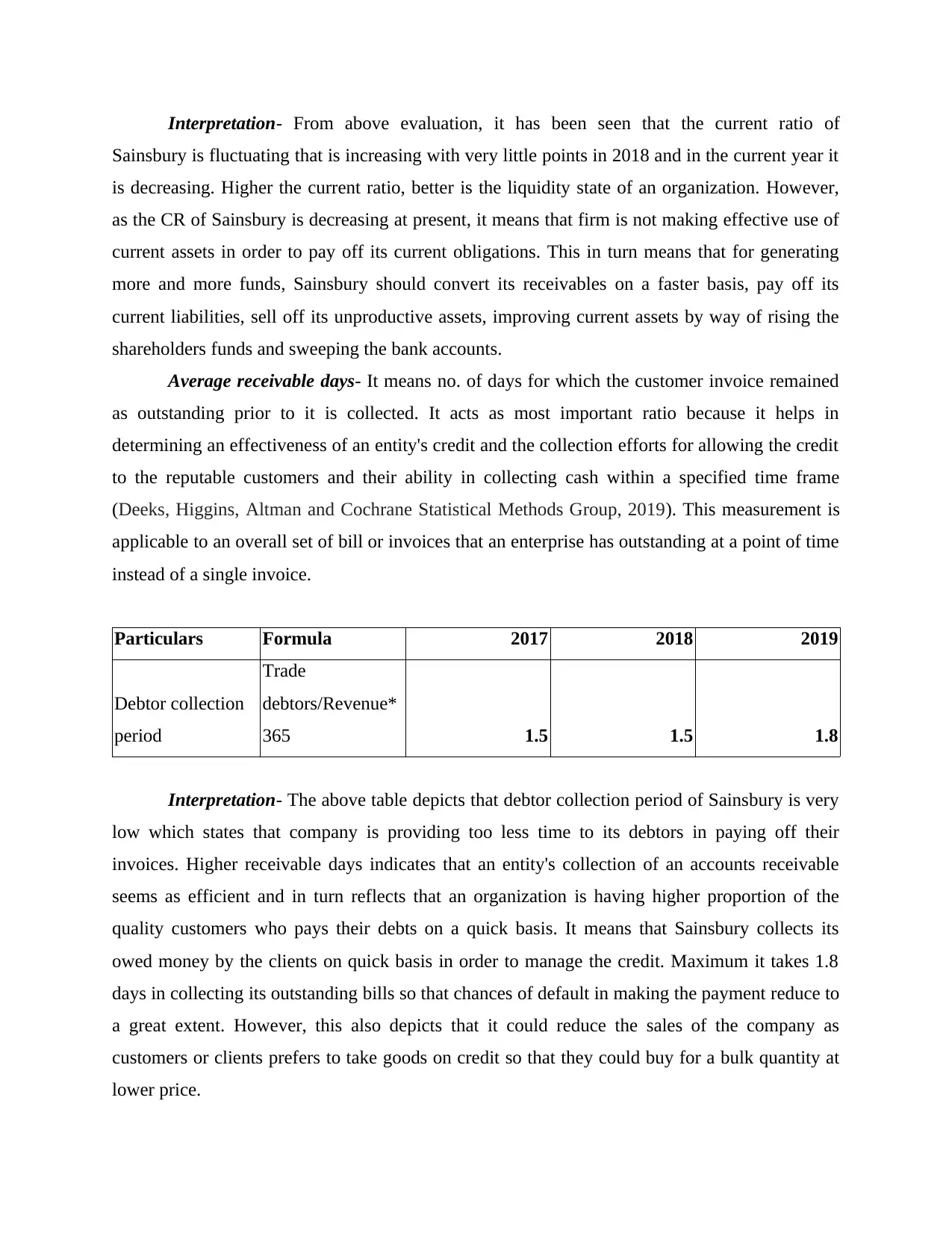
Interpretation- From above evaluation, it has been seen that the current ratio of
Sainsbury is fluctuating that is increasing with very little points in 2018 and in the current year it
is decreasing. Higher the current ratio, better is the liquidity state of an organization. However,
as the CR of Sainsbury is decreasing at present, it means that firm is not making effective use of
current assets in order to pay off its current obligations. This in turn means that for generating
more and more funds, Sainsbury should convert its receivables on a faster basis, pay off its
current liabilities, sell off its unproductive assets, improving current assets by way of rising the
shareholders funds and sweeping the bank accounts.
Average receivable days- It means no. of days for which the customer invoice remained
as outstanding prior to it is collected. It acts as most important ratio because it helps in
determining an effectiveness of an entity's credit and the collection efforts for allowing the credit
to the reputable customers and their ability in collecting cash within a specified time frame
(Deeks, Higgins, Altman and Cochrane Statistical Methods Group, 2019). This measurement is
applicable to an overall set of bill or invoices that an enterprise has outstanding at a point of time
instead of a single invoice.
Particulars Formula 2017 2018 2019
Debtor collection
period
Trade
debtors/Revenue*
365 1.5 1.5 1.8
Interpretation- The above table depicts that debtor collection period of Sainsbury is very
low which states that company is providing too less time to its debtors in paying off their
invoices. Higher receivable days indicates that an entity's collection of an accounts receivable
seems as efficient and in turn reflects that an organization is having higher proportion of the
quality customers who pays their debts on a quick basis. It means that Sainsbury collects its
owed money by the clients on quick basis in order to manage the credit. Maximum it takes 1.8
days in collecting its outstanding bills so that chances of default in making the payment reduce to
a great extent. However, this also depicts that it could reduce the sales of the company as
customers or clients prefers to take goods on credit so that they could buy for a bulk quantity at
lower price.
Sainsbury is fluctuating that is increasing with very little points in 2018 and in the current year it
is decreasing. Higher the current ratio, better is the liquidity state of an organization. However,
as the CR of Sainsbury is decreasing at present, it means that firm is not making effective use of
current assets in order to pay off its current obligations. This in turn means that for generating
more and more funds, Sainsbury should convert its receivables on a faster basis, pay off its
current liabilities, sell off its unproductive assets, improving current assets by way of rising the
shareholders funds and sweeping the bank accounts.
Average receivable days- It means no. of days for which the customer invoice remained
as outstanding prior to it is collected. It acts as most important ratio because it helps in
determining an effectiveness of an entity's credit and the collection efforts for allowing the credit
to the reputable customers and their ability in collecting cash within a specified time frame
(Deeks, Higgins, Altman and Cochrane Statistical Methods Group, 2019). This measurement is
applicable to an overall set of bill or invoices that an enterprise has outstanding at a point of time
instead of a single invoice.
Particulars Formula 2017 2018 2019
Debtor collection
period
Trade
debtors/Revenue*
365 1.5 1.5 1.8
Interpretation- The above table depicts that debtor collection period of Sainsbury is very
low which states that company is providing too less time to its debtors in paying off their
invoices. Higher receivable days indicates that an entity's collection of an accounts receivable
seems as efficient and in turn reflects that an organization is having higher proportion of the
quality customers who pays their debts on a quick basis. It means that Sainsbury collects its
owed money by the clients on quick basis in order to manage the credit. Maximum it takes 1.8
days in collecting its outstanding bills so that chances of default in making the payment reduce to
a great extent. However, this also depicts that it could reduce the sales of the company as
customers or clients prefers to take goods on credit so that they could buy for a bulk quantity at
lower price.
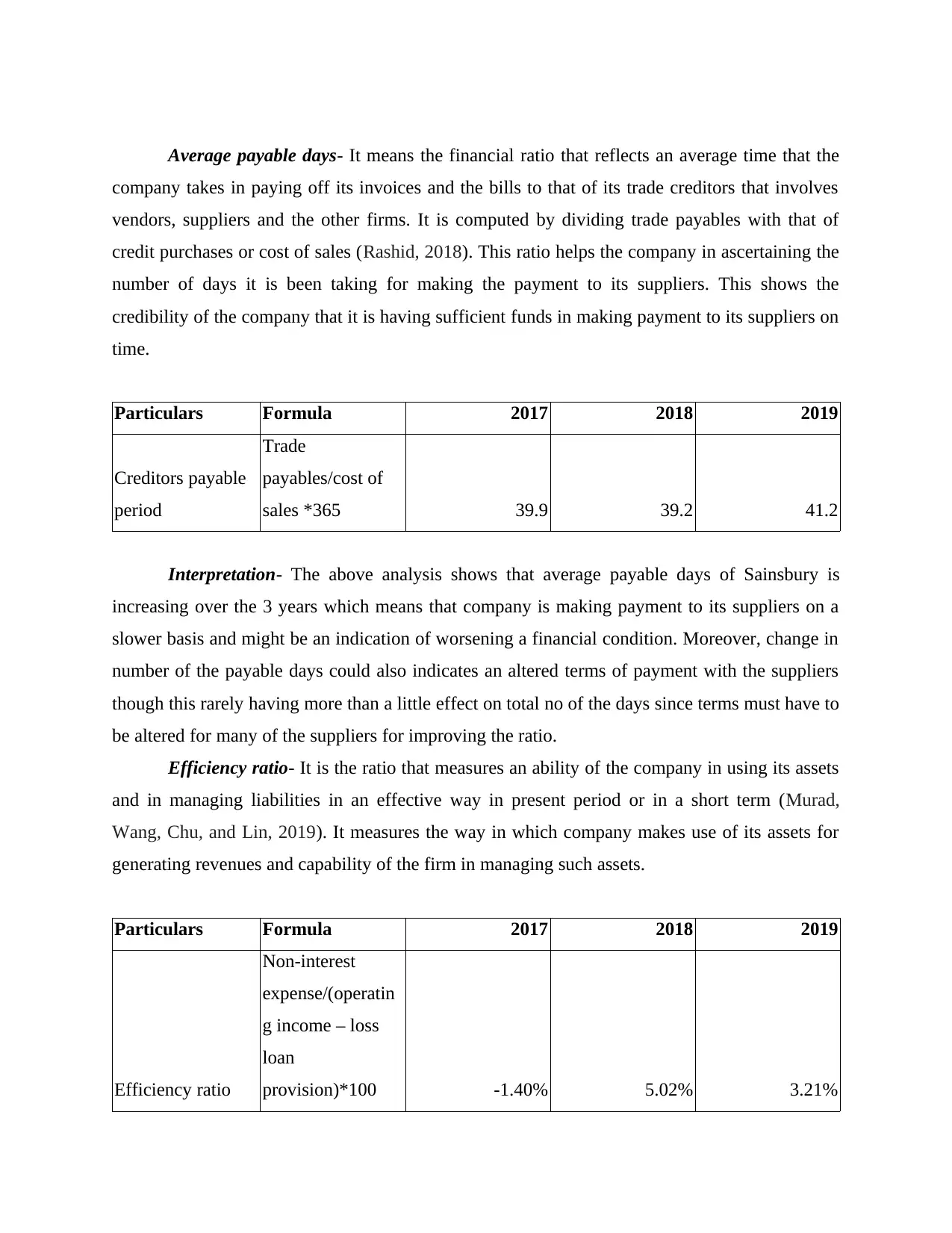
Average payable days- It means the financial ratio that reflects an average time that the
company takes in paying off its invoices and the bills to that of its trade creditors that involves
vendors, suppliers and the other firms. It is computed by dividing trade payables with that of
credit purchases or cost of sales (Rashid, 2018). This ratio helps the company in ascertaining the
number of days it is been taking for making the payment to its suppliers. This shows the
credibility of the company that it is having sufficient funds in making payment to its suppliers on
time.
Particulars Formula 2017 2018 2019
Creditors payable
period
Trade
payables/cost of
sales *365 39.9 39.2 41.2
Interpretation- The above analysis shows that average payable days of Sainsbury is
increasing over the 3 years which means that company is making payment to its suppliers on a
slower basis and might be an indication of worsening a financial condition. Moreover, change in
number of the payable days could also indicates an altered terms of payment with the suppliers
though this rarely having more than a little effect on total no of the days since terms must have to
be altered for many of the suppliers for improving the ratio.
Efficiency ratio- It is the ratio that measures an ability of the company in using its assets
and in managing liabilities in an effective way in present period or in a short term (Murad,
Wang, Chu, and Lin, 2019). It measures the way in which company makes use of its assets for
generating revenues and capability of the firm in managing such assets.
Particulars Formula 2017 2018 2019
Efficiency ratio
Non-interest
expense/(operatin
g income – loss
loan
provision)*100 -1.40% 5.02% 3.21%
company takes in paying off its invoices and the bills to that of its trade creditors that involves
vendors, suppliers and the other firms. It is computed by dividing trade payables with that of
credit purchases or cost of sales (Rashid, 2018). This ratio helps the company in ascertaining the
number of days it is been taking for making the payment to its suppliers. This shows the
credibility of the company that it is having sufficient funds in making payment to its suppliers on
time.
Particulars Formula 2017 2018 2019
Creditors payable
period
Trade
payables/cost of
sales *365 39.9 39.2 41.2
Interpretation- The above analysis shows that average payable days of Sainsbury is
increasing over the 3 years which means that company is making payment to its suppliers on a
slower basis and might be an indication of worsening a financial condition. Moreover, change in
number of the payable days could also indicates an altered terms of payment with the suppliers
though this rarely having more than a little effect on total no of the days since terms must have to
be altered for many of the suppliers for improving the ratio.
Efficiency ratio- It is the ratio that measures an ability of the company in using its assets
and in managing liabilities in an effective way in present period or in a short term (Murad,
Wang, Chu, and Lin, 2019). It measures the way in which company makes use of its assets for
generating revenues and capability of the firm in managing such assets.
Particulars Formula 2017 2018 2019
Efficiency ratio
Non-interest
expense/(operatin
g income – loss
loan
provision)*100 -1.40% 5.02% 3.21%
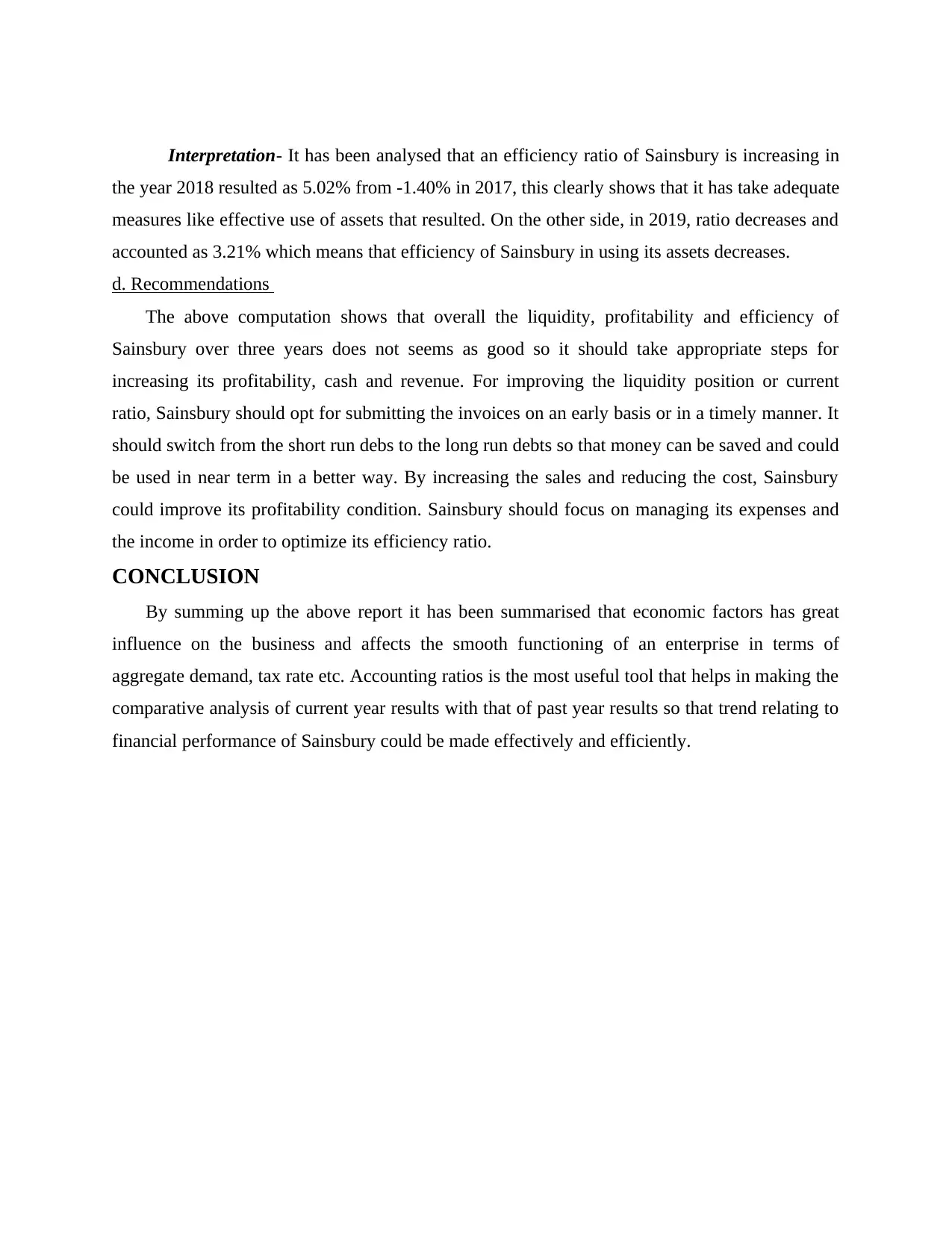
Interpretation- It has been analysed that an efficiency ratio of Sainsbury is increasing in
the year 2018 resulted as 5.02% from -1.40% in 2017, this clearly shows that it has take adequate
measures like effective use of assets that resulted. On the other side, in 2019, ratio decreases and
accounted as 3.21% which means that efficiency of Sainsbury in using its assets decreases.
d. Recommendations
The above computation shows that overall the liquidity, profitability and efficiency of
Sainsbury over three years does not seems as good so it should take appropriate steps for
increasing its profitability, cash and revenue. For improving the liquidity position or current
ratio, Sainsbury should opt for submitting the invoices on an early basis or in a timely manner. It
should switch from the short run debs to the long run debts so that money can be saved and could
be used in near term in a better way. By increasing the sales and reducing the cost, Sainsbury
could improve its profitability condition. Sainsbury should focus on managing its expenses and
the income in order to optimize its efficiency ratio.
CONCLUSION
By summing up the above report it has been summarised that economic factors has great
influence on the business and affects the smooth functioning of an enterprise in terms of
aggregate demand, tax rate etc. Accounting ratios is the most useful tool that helps in making the
comparative analysis of current year results with that of past year results so that trend relating to
financial performance of Sainsbury could be made effectively and efficiently.
the year 2018 resulted as 5.02% from -1.40% in 2017, this clearly shows that it has take adequate
measures like effective use of assets that resulted. On the other side, in 2019, ratio decreases and
accounted as 3.21% which means that efficiency of Sainsbury in using its assets decreases.
d. Recommendations
The above computation shows that overall the liquidity, profitability and efficiency of
Sainsbury over three years does not seems as good so it should take appropriate steps for
increasing its profitability, cash and revenue. For improving the liquidity position or current
ratio, Sainsbury should opt for submitting the invoices on an early basis or in a timely manner. It
should switch from the short run debs to the long run debts so that money can be saved and could
be used in near term in a better way. By increasing the sales and reducing the cost, Sainsbury
could improve its profitability condition. Sainsbury should focus on managing its expenses and
the income in order to optimize its efficiency ratio.
CONCLUSION
By summing up the above report it has been summarised that economic factors has great
influence on the business and affects the smooth functioning of an enterprise in terms of
aggregate demand, tax rate etc. Accounting ratios is the most useful tool that helps in making the
comparative analysis of current year results with that of past year results so that trend relating to
financial performance of Sainsbury could be made effectively and efficiently.
Paraphrase This Document
Need a fresh take? Get an instant paraphrase of this document with our AI Paraphraser
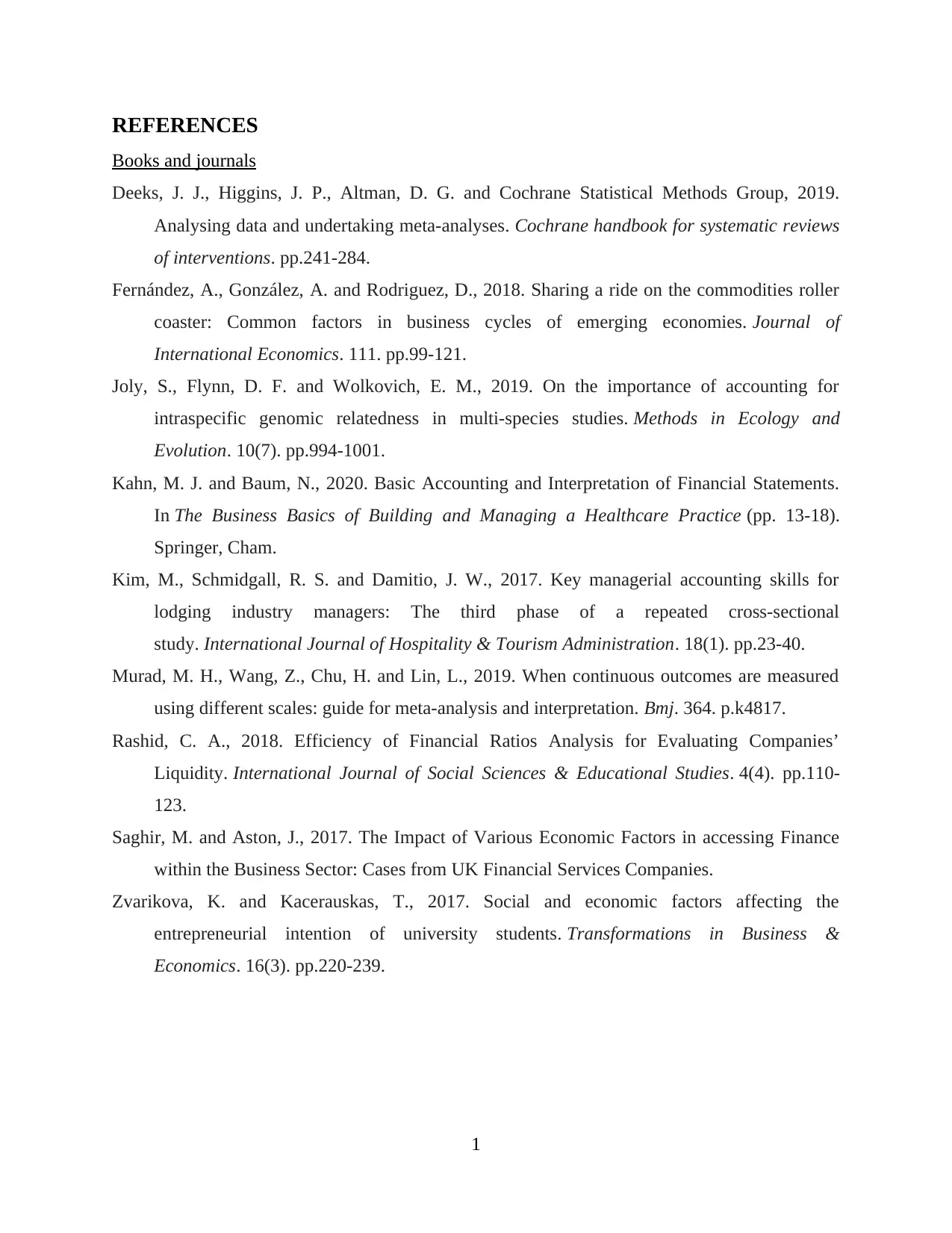
REFERENCES
Books and journals
Deeks, J. J., Higgins, J. P., Altman, D. G. and Cochrane Statistical Methods Group, 2019.
Analysing data and undertaking meta‐analyses. Cochrane handbook for systematic reviews
of interventions. pp.241-284.
Fernández, A., González, A. and Rodriguez, D., 2018. Sharing a ride on the commodities roller
coaster: Common factors in business cycles of emerging economies. Journal of
International Economics. 111. pp.99-121.
Joly, S., Flynn, D. F. and Wolkovich, E. M., 2019. On the importance of accounting for
intraspecific genomic relatedness in multi‐species studies. Methods in Ecology and
Evolution. 10(7). pp.994-1001.
Kahn, M. J. and Baum, N., 2020. Basic Accounting and Interpretation of Financial Statements.
In The Business Basics of Building and Managing a Healthcare Practice (pp. 13-18).
Springer, Cham.
Kim, M., Schmidgall, R. S. and Damitio, J. W., 2017. Key managerial accounting skills for
lodging industry managers: The third phase of a repeated cross-sectional
study. International Journal of Hospitality & Tourism Administration. 18(1). pp.23-40.
Murad, M. H., Wang, Z., Chu, H. and Lin, L., 2019. When continuous outcomes are measured
using different scales: guide for meta-analysis and interpretation. Bmj. 364. p.k4817.
Rashid, C. A., 2018. Efficiency of Financial Ratios Analysis for Evaluating Companies’
Liquidity. International Journal of Social Sciences & Educational Studies. 4(4). pp.110-
123.
Saghir, M. and Aston, J., 2017. The Impact of Various Economic Factors in accessing Finance
within the Business Sector: Cases from UK Financial Services Companies.
Zvarikova, K. and Kacerauskas, T., 2017. Social and economic factors affecting the
entrepreneurial intention of university students. Transformations in Business &
Economics. 16(3). pp.220-239.
1
Books and journals
Deeks, J. J., Higgins, J. P., Altman, D. G. and Cochrane Statistical Methods Group, 2019.
Analysing data and undertaking meta‐analyses. Cochrane handbook for systematic reviews
of interventions. pp.241-284.
Fernández, A., González, A. and Rodriguez, D., 2018. Sharing a ride on the commodities roller
coaster: Common factors in business cycles of emerging economies. Journal of
International Economics. 111. pp.99-121.
Joly, S., Flynn, D. F. and Wolkovich, E. M., 2019. On the importance of accounting for
intraspecific genomic relatedness in multi‐species studies. Methods in Ecology and
Evolution. 10(7). pp.994-1001.
Kahn, M. J. and Baum, N., 2020. Basic Accounting and Interpretation of Financial Statements.
In The Business Basics of Building and Managing a Healthcare Practice (pp. 13-18).
Springer, Cham.
Kim, M., Schmidgall, R. S. and Damitio, J. W., 2017. Key managerial accounting skills for
lodging industry managers: The third phase of a repeated cross-sectional
study. International Journal of Hospitality & Tourism Administration. 18(1). pp.23-40.
Murad, M. H., Wang, Z., Chu, H. and Lin, L., 2019. When continuous outcomes are measured
using different scales: guide for meta-analysis and interpretation. Bmj. 364. p.k4817.
Rashid, C. A., 2018. Efficiency of Financial Ratios Analysis for Evaluating Companies’
Liquidity. International Journal of Social Sciences & Educational Studies. 4(4). pp.110-
123.
Saghir, M. and Aston, J., 2017. The Impact of Various Economic Factors in accessing Finance
within the Business Sector: Cases from UK Financial Services Companies.
Zvarikova, K. and Kacerauskas, T., 2017. Social and economic factors affecting the
entrepreneurial intention of university students. Transformations in Business &
Economics. 16(3). pp.220-239.
1

2
1 out of 15
Related Documents
Your All-in-One AI-Powered Toolkit for Academic Success.
+13062052269
info@desklib.com
Available 24*7 on WhatsApp / Email
![[object Object]](/_next/static/media/star-bottom.7253800d.svg)
Unlock your academic potential
© 2024 | Zucol Services PVT LTD | All rights reserved.





